
America's Housing Crisis: A Reading List
Conor Dougherty on the Books That Shaped His Understanding of the Problem
As a journalist, I’m always doing two things: Reporting and writing. My reading falls along the same lines. I read one kind of book because I’m interested in a topic and want to mine it for details, context or ideas (reporting). I read a second kind of book because I want to see how different people are making and telling stories (writing).
The first kind of book is pretty specific to what I’m working on and tends to be works whose main job is to inform. Sometimes that means academic tomes that maybe five other people have read, but I also read a lot of popular history, especially histories of California. The second kind of book is much more wide-ranging—fiction, nonfiction, essays etc.
Obviously the two piles blend together a lot; anytime you read a book, even a bad one, you see someone do something you hadn’t thought of before, and it informs how you approach your next piece. Here are some books (and an art show) that I read or consulted or was inspired by while writing my new book Golden Gates: Fighting for Housing in America. Warning: They are all over the place, but are a mix of books about housing, cities and places, and works whose narrative methods I found intriguing and useful.
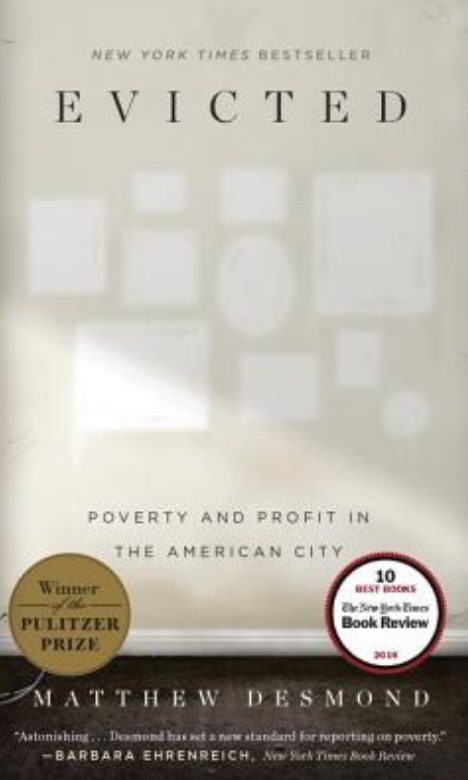
Matthew Desmond, Evicted: Poverty and Profit in the American City
For this generation of housing writers, it is the work against which so much else is measured. Desmond calls himself a sociologist and is a professor at Princeton, but actually he’s a journalist who at a relatively young age has established himself as America’s preeminent chronicler of poverty. Poverty is a tough topic. It’s always there, always sad—and always hard to say something new about. Evicted sparked a national conversation about the never-ending shame of having so much want in a country with so much wealth. By shifting perspectives from a landlord who is exploiting tenants while struggling to maintain a middle-class lifestyle to renters who are constantly on the edge of homelessness, the book sees no boogeymen but only a rotten system that we’re all caught up in one way or the other.
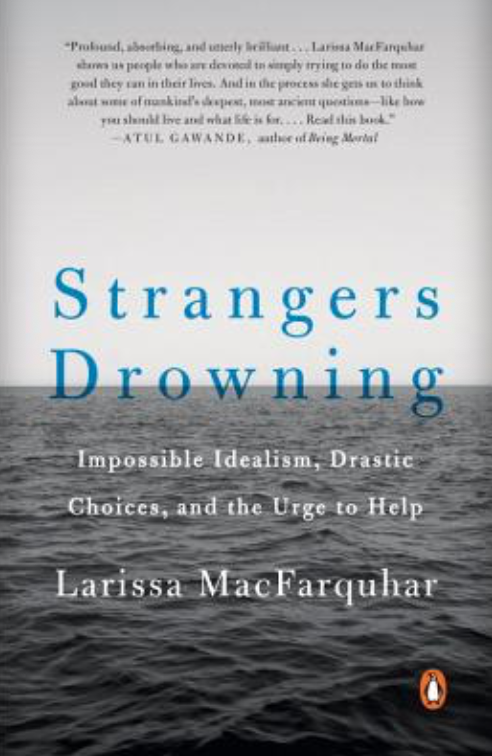
Larissa MacFarquhar, Strangers Drowning: Impossible Idealism, Drastic Choices, and the Urge to Help
My current favorite book. In a world in which seemingly every reporter is opining too much and tweeting too much and first-person essaying too much, MacFarquhar is a relative enigma. She’s not a hermit or anything; you can find interviews and TED Talks and whatnot. But she steers clear of the first person, leaves out most interview quotes, and tries to inhabit her subjects by using free indirect speech. The effect of these decisions is to elevate her vision while reducing her presence. It’s original, brilliant and makes for some of the best writing I’ve seen in any form.
Methods aside, Strangers Drowning is a timeless story about extreme altruists—do-gooders whose lives are so dedicated to helping people that they end up sacrificing most of their personal, professional and family lives. It seems weird to call such a cerebral book a rollercoaster, but the emotional progression of reading it is intense. You start the book feeling like a selfish piece of garbage. Toward the middle you’re convinced that her subjects are defects who have been cursed with the mirror image of psychopathy. By the end you just go “people are crazy, man,” and leave it at that. It’s a journey into the soul that becomes a journey into the mind and leaves you scratching your head at the remarkable complexity of kindness. I’ve bought maybe ten copies of this book to give out as gifts, and gave two to sources during the reporting of Golden Gates.

Nikole Hannah-Jones, Living Apart: How the Government Betrayed a Landmark Civil Rights Law
Every reporter who has expressed even a modest interest in history has at some point had an editor say some version of “this is a newspaper not a library.” Hannah-Jones has become one of the most decorated journalists of her generation by breaking that rule, most prominently with The New York Times’s 1619 Project, and here in Living Apart, which is essentially a long magazine article turned eBook.
The premise of this piece is how the federal government neglected to enforce the 1968 Civil Rights Act by refusing to use the cudgel of Housing and Urban Development infrastructure money to force exclusive suburbs to build affordable housing and curb restrictive zoning practices. This decision, originally made by the Nixon Administration, continued for four decades, perpetuating segregation long after fair housing—passed in the aftermath of Martin Luther King Jr.’s assassination—was the law of the land.
Given that this piece was published in 2012, the trick of the story, like a good amount of Hannah-Jones’s work, is to pull history into the present by showing how decisions made decades ago continue to guide us today. The most remarkable thing about the reporting is that it leaves zero question that the Nixon Administration knew exactly what it was doing in neglecting to enforce fair housing. They also knew this decision would cause great harm to American unity and have consequences for many generations.
In a batch of talking points for the president, George Romney, Nixon’s HUD chief and the father of Senator Mitt Romney, warns that de-segregationist housing policies are needed to prevent “our nation from being torn apart.”
President Nixon refuses, but understands the consequences. “I realize that this position will lead us to a situation in which blacks will continue to live for the most part in black neighborhoods and where there will be predominately black schools and predominately white schools,” Nixon wrote in a memo Hannah-Jones unearthed.
This is one of those “both buckets” pieces. I consulted it several times while writing Golden Gates, first for the housing stuff, but also to guide my thinking on how to make Chapter 4, which starts at the close of World War II and ends in the early 1980s, resonate today. My solution was to weave in the story of a developer who moved to California as a 10-year-old during the state’s 1960s population boom and started his career during the housing crisis of the 1970. Later, the book catches up with him as 65-year-old developer today, to show just how little had changed.
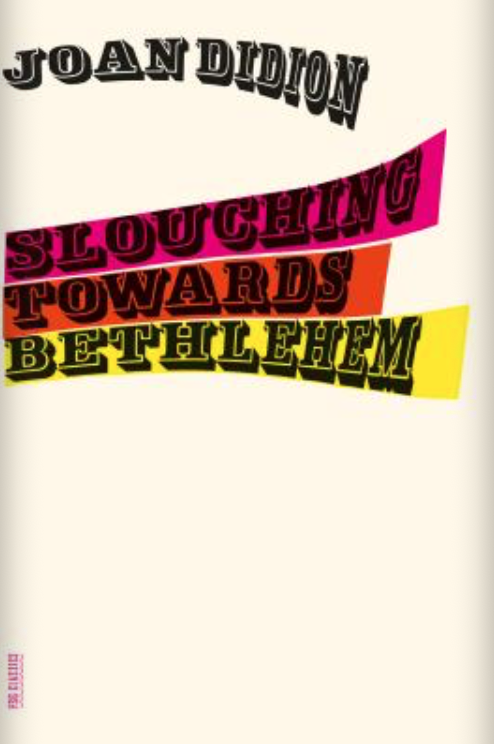
Joan Didion (audiobook by Diane Keaton), Slouching Towards Bethlehem
There’s nothing I can say about Joan Didion that hasn’t already been said, so let me take this opportunity to say that I don’t care how many times you’ve read Slouching, you haven’t experienced it in full until you’ve heard Diane Keaton’s reading of the audiobook. I missed my BART stop listening to it because I got so carried away by her voice.
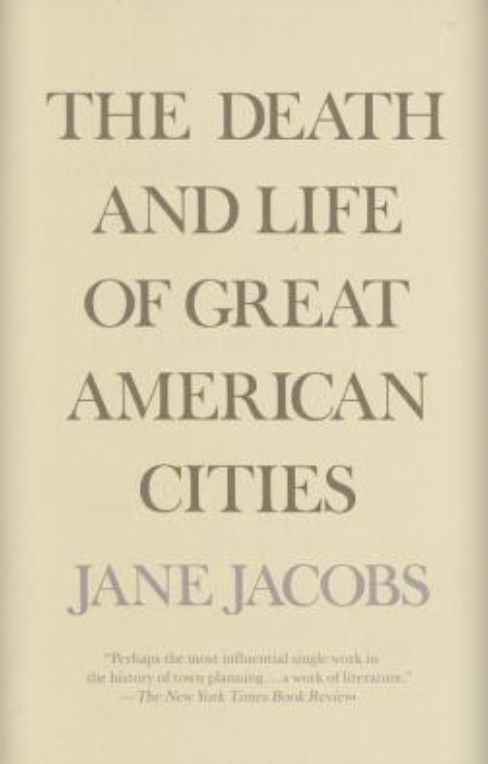
Jane Jacobs, The Death and Life of Great American Cities
For years I’ve wanted to write a brainy essay about the differing ways in which Joan Didion and Jane Jacobs handle the chaos of youth and urbanity, but it’s never really gelled and therefore remains more of a feeling than a coherent thought. The writers are just so different, and their fields of study so distinct. And yet, in my mind I always pair them because of the opposite emotions I walk away with after reading them. Whereas Didion sees chaos everywhere, Jacobs—who is a better pure reporter—sees the underlying logic of systems that appear disorderly on the surface. There’s a basic optimism in that: Messy stuff works. People are adaptable. Life goes on. One of the most discouraging things about politics is the way people become advocates for policies over outcomes, which means the same batch of advocates can sometimes be the cure and other times be the disease. Jacobs was an advocate, but she’s also fluid and thoughtful, presenting guidelines for good urbanism yet allowing that they have to flexible and malleable for cities to remain vibrant.

Karen Russell, Vampires in the Lemon Grove
I read Karen Russell the way novelists read poets: To see where the boundaries are. Fiction or nonfiction, writing is a bizarre exercise. You encounter a person, idea, dream or scene or emotion, then try to recreate the same details and feeling with a bunch of marks on a page. And you do this in hopes of forging some strange telepathy with people you’ll never meet. It’s hard stuff, so even though I’m squarely into journalism, I still find it enriching to spend time reading novelists and short story writers who are opening new pathways. It reminds me that nothing is impossible, that the word “indescribable” is bullshit, and that however much difficulty I’m having rendering some scene, someone else is struggling with something infinitely more difficult.
In terms of my reading experience, I liked the title story of Vampires most, but the one that made the greatest impression on me is “The Barn at the End of Our Term.” It’s a story about President Rutherford B. Hayes being reincarnated as a horse. If you asked me to explain why I found this interesting, I couldn’t do it. But Karen Russell could, because she can do anything.
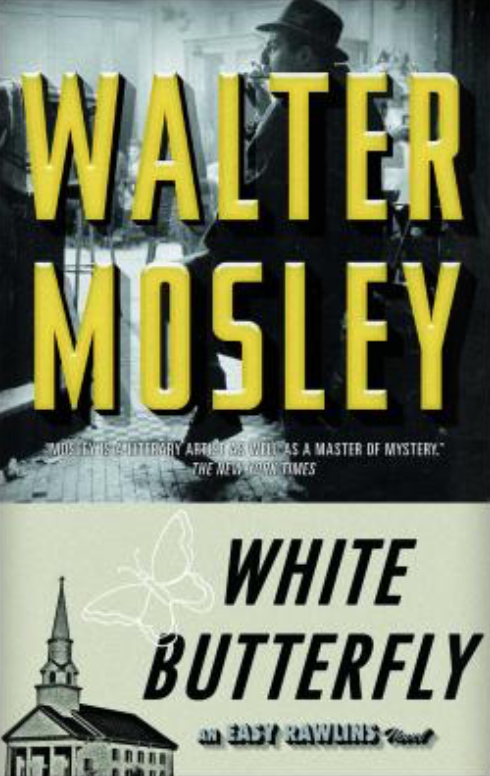
Walter Mosley, White Butterfly
Look, everyone needs to unwind with a little detective fiction now and then. And if you’re going to do detective fiction, you might as well dive into one of America’s greatest literary traditions, which is detective fiction about LA. There’s so much out there—Raymond Chandler, Michael Connelly—but I always come back to the Easy Rawlins series.
Easy is a stereotypically complicated protagonist, and his best friend is a sociopathic murderer, but once you get past all that, you realize that some of the best stuff in these books is all the domestic juggling Easy has to deal with in the midst of his detective work. Property is central to this story and Easy’s evolution as a character. He’s struggling with the mortgage in the first book, upgrades to landlording in the second, and by the time of White Butterfly is a small-time mogul who has gone to some lengths to hide this fact. Real estate is a hustle that a stunning number of people—rich, poor and middle—have all got their hands in. In this way Easy is just another ordinary American trying to find his way to passive income.

George Packer, The Unwinding: An Inner History of the New America
The New York Times called this a “nonfiction masterpiece.” It is nothing short of that. The premise of the book—democracy in crisis—is the sort of amorphous topic that seems impossible to execute in nonfiction. There’s just so much going on. But Packer unpacks his tale one character at a time, and in doing so manages to accomplish his audacious goal of constructing an “inner history” of America.
The main stories are deep and well-told—the decline of a factory town, the growth of Silicon Valley, a starry-eyed optimist turned cynical political consultant—and along the way Packer gives readers a kind of cultural download via short, interlude biographies on subjects including Oprah Winfrey, Sam Walton, Raymond Carver, Andrew Breitbart and Jay-Z. Like all the best writers, you know exactly what Packer thinks without ever hearing him say it. The effect of reading this book is not unlike the effect of fading into a nine-minute Prog Rock song with multiple solos and time signature changes. You wonder how something so vast and complex can work while simultaneously appreciating that somehow it just does.
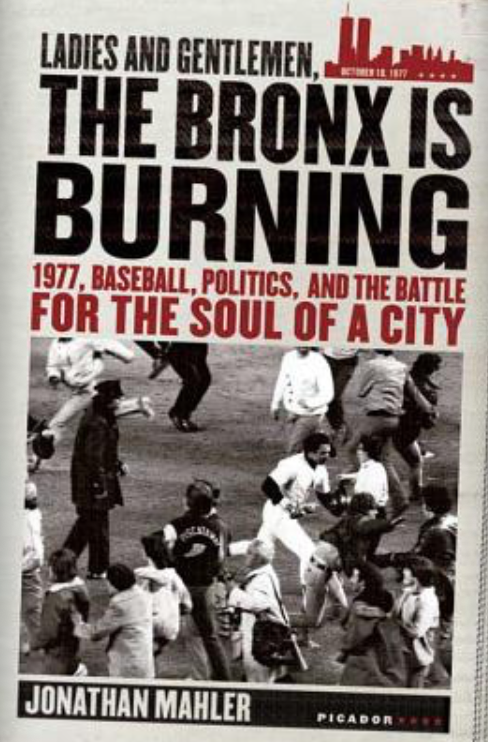
Jonathan Mahler, Ladies and Gentlemen, the Bronx Is Burning: 1977, Baseball, Politics, and the Battle for the Soul of a City
On the surface, it seems like a risky idea: The history of one year in New York, tracing crime, the mayoral election, and baseball. New York is a big and important place, but it’s not so big or important to make an easy sell of a book about a World Series whose outcome is well-known or a local election whose results most of America doesn’t care about. And yet, Mahler pulls it off. What makes this book so great, beyond the depth of reporting and the easy, vivid writing, is that it’s less a story about New York than a story about the nadir of American cities. Reading the book—the city teetering on bankruptcy, the Son of Sam murders, the 1977 blackout and looting—you wonder how the place can ever recover.
With hindsight, however, we know that shortly after the story closes, New York and big US cities across the country begin a slow recovery that 40 years later would result in the gentrification fights we see today. This makes Mahler’s book feel like a prequel to the modern American city, and the experience of reading it is a reminder of the adage that predictions are hard, especially about the future.
I suspect that in the year 2040 or so, someone (maybe me), could write a great book about how the San Francisco of 2019 or 2020 told us much about where America, cities and the economy was headed. In a way I tried to do that with Golden Gates, but as time goes on the implications will become clearer and gift some future author with a wealth of political and cultural detail of the sort that Mahler mines so expertly.
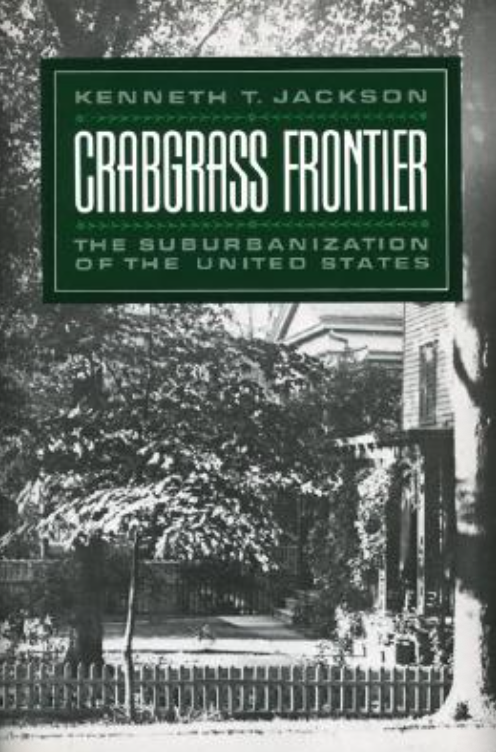
Kenneth T. Jackson, Crabgrass Frontier: The Suburbanization of the United States
“Throughout history, the treatment and arrangement of shelter have revealed more about a particular people than have any other products of creative arts. Housing is an outward expression of the inner human nature; no society can be fully understood apart from the residences of its members.”
So begins Crabgrass Frontier, the definitive history of American suburbs. The book was published in 1985 but remains the best look at suburbanization and its consequences for American society. I suppose that’s not surprising, since an event as epochal as suburbanization would be expected to have staying power. Jackson goes through the whole thing, tracking suburbs from pre-history through early America and the Postwar boom. The suburbs, then and now, are built on transportation. As the book progresses, Jackson lays out how each successive leap of mobility opens more land—linear carriages and trains gave way to geometric freeways—available for urban development.
What’s most remarkable about this work is its capacity to look forward. At the end Jackson predicts that inner-city crime rates will fall precipitously and that over time far-flung suburbs would become poorer and less desired as central cities become safer and richer. Pretty bold prediction in the mid-1980s, but it was spot on, and we’re now living with the consequences.

Richard Rothstein, The Color of Law: A Forgotten History of How Our Government Segregated America
The Color of Law is framed as something between a very long essay and a legal argument. In the introduction Rothstein lays out his case for America’s racially homogeneous neighborhoods being a consequence of de jure segregation (segregation by law or public policy) versus de facto segregation (segregation resulting from private practices). It’s a fascinating framing. As I read the book, I kept thinking about a theoretical court case in which black Americans could sue their government for the vast wealth transfers that occurred via lost housing wealth. How many trillions would it add up to?
Thus, while my tastes gravitate toward sprawling, character-driven books, the power of this one flows from the simplicity of the argument and Rothstein’s relentless focus in proving it. Rothstein did not discover racism, and he didn’t discover the Federal Housing Administration’s redlining guidelines or restrictive covenants either. Various authors, historians and essayists have trod this ground several times before. But the way he assembles this history is unique and abundantly helpful. Page after page and example after example he leaves zero doubt that segregation is not something that just happened but was planned and executed by a federal government whose societal debt will take centuries, if ever, to repay.

Kevin Starr, Golden Dreams: California in an Age of Abundance
Ask anyone who is even remotely serious about California history what you need to read to get started, and the answer is always Kevin Starr. And it’s always the correct response: He is the master. This is where I note that, as much as I wish everyone was as fascinated with California as I am, Starr is not for casual readers. As the former state librarian and foremost chronicler of the Golden State, his books sag under the weight of their comprehension. Take Golden Dreams, which covers a relative burp of history—California from 1950 to 1963—yet is almost 600 pages and roughly 250,000 words. To get through Starr’s entire Americans and the California Dream series, which covers about 150 years, you’ll need to put aside time for seven more volumes and well in excess of a million more words.
I have them all, but if you’re going to read one book from the canon, Golden Dreams is it, because that was the period when California really took over the nation’s politics and economy. The book goes deep into the West Coast psyche, pulling together a vast trove of cultural, economic and political history mixed with long chunks of literary criticism. By the end you’ve covered subjects ranging from the architectural marvel of stacked multi-level interchanges to the horticultural tinkering that gave us freeway landscaping to the instructional images of Sunset magazine, the styles of Williams-Sonoma, the religiousness of Big Sur, and the highbrow strategy of the San Francisco 49ers’ offense. The book has an entire chapter analyzing the “Baghdad by the Bay” metaphor that Herb Caen deployed in his columns for the San Francisco Chronicle. It’s a lot.
Speaking of metaphors, after all this excess, Starr ends with stunningly elegant conclusion, which is that the result of California’s wealth and abundance was a rebellion to the simple designs and style choices that have come to define Apple products and gave rise to the concept we call “coolness.” “There was, to put the matter simply, a lot of money flowing through the society, hence a lot of jobs and careers open to talent, hence the filling in of domestic space with iconic manifestations of the new consumer lifestyle— stereophonic sound systems, electric appliances, modernist furniture, abstract art and sculpture, Space Age silver and flatware, fabrics in unprecedented colors, designer jewelry and eyewear,” he writes. “Hence the effort to keep this consumption under control by banishing clutter from interiors, appliance design, and related items… Coolness, from this perspective, constituted a kind of asceticism, an insistence upon choice and restraint, in a world filling up with consumer goods.”
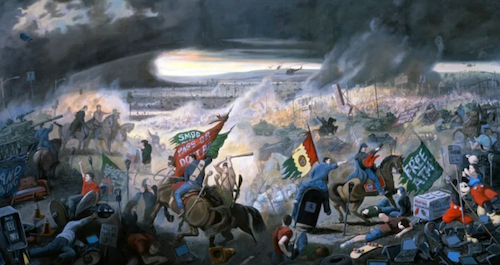
Honorable Mention: Sandow Birk, In Smog and Thunder: The Great War of the Californias
Technically this isn’t a book (though you can buy one). It’s an art exhibit that I saw at the Laguna Art Museum in 2000, shortly after I moved to LA from San Francisco. The premise of the show, more than 120 artworks, is that NorCal and SoCal fought an actual war and these are the paintings that documented it. The result is a bunch of epic, oil on canvas scenes with names like “The Bombing of the Getty Center” and “SF MOMA and the Battle of San Francisco.” The concept is hilarious, the paintings are gorgeous, and the story is sly. If you’ve spent any amount of time in either SF or LA, this will resonate.
_____________________________________

Golden Gates: Fighting For Housing in America by Conor Dougherty, is available now from Penguin Press.
Conor Dougherty
Conor Dougherty is an economics reporter at The New York Times. He previously spent a decade in New York covering housing and the economy for The Wall Street Journal. He grew up in the Bay Area and lives with his family in Oakland.












